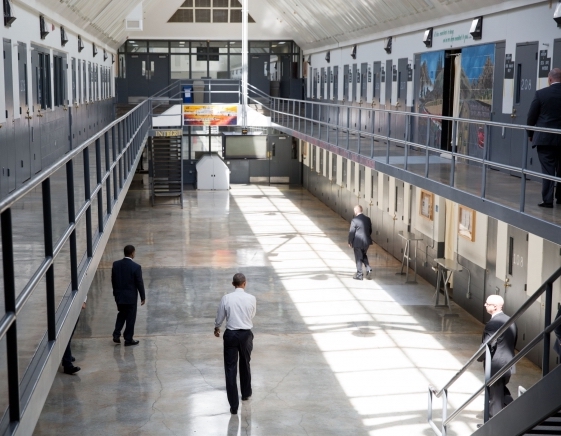
Last month, President Obama became the first sitting president to visit a federal prison, touring the El Reno Federal Correctional Institution in Oklahoma. During his visit, he acknowledged that if it weren’t for the privilege of his family support, he could have ended up inside prison walls rather than inside the White House.
The visit capped off more than a week of speeches and announcements about criminal justice reform, including the commutation of 46 people who were given mandatory minimum jail sentences for drug offenses. The President also addressed the national convention of NAACP, calling for sweeping changes to the “broken” criminal justice system.
The President’s call is part of a growing bipartisan movement for reform. Last month, EJUSA’s Marc Hyden gave a briefing to staffers from both sides of the aisle on Capitol Hill, and groups like the ACLU, the Center for American Progress, Right on Crime, the Faith and Freedom Coalition, and others are forming coalitions to work together. The need for reform is becoming a hot topic for celebrities, candidates, lawmakers, and organizations.
This is great news. But despite this broad spectrum of support, EJUSA believes the conversation isn’t quite broad enough.
Much of the focus on ending mass incarceration centers on the need to reduce or eliminate sentences for drug crimes or other offenses categorized as nonviolent. In response, several recent articles make the case that reducing or ending these sentences alone will not make a significant dent in mass incarceration, and the only real solution is to also release people convicted of violent crimes. The New York Times recently featured a new tool by the Urban Institute that allows you to select a policy change and see how it will impact the prison population.
“The mass incarceration debate too often gets mired in false choices between addressing the problem on the front or back end (admissions versus length of stay) and questions about the relative impact of focusing on nonviolent or violent offenses,” writes the Urban Institute.
The debate also gets mired in the false choice of locking people up or doing nothing, but much gets lost in these simplistic dichotomies. By focusing exclusively on how many people are in prison and whether or not to let them out, a range of questions are missed: how to help people harmed by crime to rebuild their lives, how to prevent violence before it occurs, and how people can be accountable to those they’ve harmed in ways that are forward-looking and constructive.
A recent study of people on death row in Texas found “a litany of childhood horror” in the backgrounds of the people who committed capital crimes. The article goes on to quote a range of research that backs up the finding. One study found that among 43 men on death row, “an astonishing 94 percent had been physically abused, 59 percent sexually abused, and 83 percent had witnessed violence in adolescence.” Another by a U.K. professor identified that trauma experiences in childhood are key features for young people who commit violence. Her study found 91 percent of young offenders had experienced abuse and/or loss.
This research lends insights that go beyond the narrow question of whether and how to punish people, indicating that many violent crimes might be prevented if we do a better job identifying and treating trauma when it happens. The discussion around criminal justice reform must expand to include developing effective responses to violence that address trauma, meet the needs of the people harmed, and break the cycle of both violence and incarceration in the future. EJUSA’s growing trauma advocacy program seeks to ensure that this part of the conversation isn’t lost.
Photo credit: “President Barack Obama walks in the Residential Drug Abuse Prevention Unit at El Reno Prison after making a statement to the press, in El Reno, Okla., July 16, 2015.” Official White House Photo by Pete Souza, public domain.



